
The Prag Mahal is a 19th-century palace located next to the Aina Mahal in Bhuj, Kutch, Gujarat, India.

The Prag Mahal is a 19th-century palace located next to the Aina Mahal in Bhuj, Kutch, Gujarat, India.
Prag Mahal is named after Rao Pragmalji II, who commissioned it and construction began in 1865. [1] [2] It was designed by Colonel Henry St Clair Wilkins in what the local tourist office describes as the Italian Gothic style, [3] although it would be better described as a Romanesque architecture twist on the Indo-Saracenic Revival style, and many Italian artisans were involved in its construction. [2] The palace artisans' wages were paid in gold coins. [4] Construction of the palace, which ultimately cost 3.1 million rupees, [2] was completed in 1879 during the regency of Khengarji III (Pragmalji II's son) following Pragmalji II's death in 1875. [1] [5] [6] The local Kutchi builder community (Mistris of Kutch) were also involved in construction of Prag Mahal along with Colonel Wilkins. [7] [8]
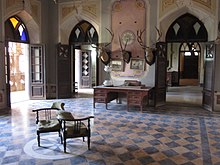
The 2001 Gujarat earthquake severely damaged the palace. [11] In 2006, the palace was burgled, with thieves stealing antiques worth millions of rupees and damaging other items throughout the palace. [2] As of 2007, the palace was in a "ghostly", "forlorn" state. [10] The palace and the tower were later repaired, after Amitabh Bachchan took personal interest in restoration of palace, [11] and its tower and clock have been repaired and are now open for public viewing. The Darbar Hall of the majestic Pragmahal Palace was renovated by the Maharao Pragmalji-III at a personal cost of Rs 5 crore. Visitors may enter the main palace halls and ascend the bell tower, which offers views of the city. [1] [3]
Scenes from the Bollywood blockbusters Hum Dil De Chuke Sanam and Lagaan , as well as a number of Gujarati films, were shot in the palace. [2] [10]

Kutch district, officially spelled Kachchh, is a district of Gujarat state in western India, with its headquarters (capital) at Bhuj. Covering an area of 45,674 km2, it is the largest district of India. The area of Kutch District is larger than the entire area of states like Haryana (44,212 km2) and Kerala (38,863 km2). The population of Kutch is about 2,092,371. It has 10 talukas, 939 villages and 6 municipalities. The Kutch district is home to the Kutchi people who speak the Kutchi language.

The 2001 Gujarat earthquake, also known as the Bhuj earthquake, occurred on 26 January at 08:46 am IST. The epicentre was about 9 km south-southwest of the village of Chobari in Bhachau Taluka of Kutch (Kachchh) District of Gujarat, India.

Bhuj is a Municipality and District Headquarters of Kutch District in the state of Gujarat, India.

Anjar is a town, township and municipality of the Kachchh district (Kutch)in the state of Gujarat, India. Founded in 650 AD, Anjar is a culturally diverse town of historic importance in the region. It is home to several historic religious temples, including the Jesal-Toral Shrines built in honour of a fourteenth century couple, whose lives inspired works of art and cinema. The town was devastated by several earthquakes, including the 1819 Rann of Kutch earthquake and 2001 Gujarat earthquake. In recent years, Anjar has become a hub of manufacturing activity.
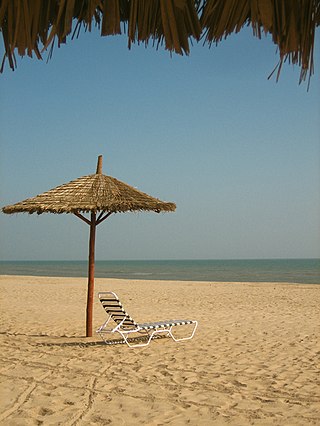
Mandvi is a Beach town with municipality in the Kachchh district (Kutch) in the Indian state of Gujarat. It was once a major port of the region and summer retreat for Maharao (king) of the Cutch State. The old city was enclosed in the fort wall and remains of the fort wall can still be seen. The city has a four-hundred-year-old ship building industry which is still functional and dhows, a type of wooden ship, are still made. Mandvi Municipality's 36 Seat Of 9 Ward.
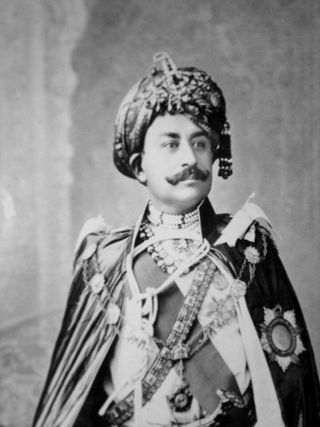
Maharajadhiraj Mirza Maharao Sir Khengarji III Sawai Bahadur was a progressive and one of the longest ruling monarchs and also the longest ruling king of the Princely State of Kutch from 1875 to 1942.

The Aina Mahal is an 18th-century palace that is located next to the Prag Mahal in Darbargadh, Bhuj, Kutch, Gujarat, India. The palace was built by Rao Lakhpatji of Kutch State around 1750. Lakhpatji's master craftsman Ram Singh Malam designed the palace in the local style and decorated it in the European style with glass, mirrors and tiles. The palace had two floors; the first floor has the Audience Hall, the Pleasure Hall, the Hall of Mirrors and the State Apartments, and the second floor has the ante-chamber, Darbar (Court) Hall and Marriage Hall. The building has been converted into a museum which includes a "europeanerie" collection that includes clocks, wares, mechanical toys, paintings and pictures.
Gaidher / Gaidhar also known as Gajdhar is a word of Gujarati, Kutchi and Rajasthani language. The word Gaidher derives its origin from the word Gadh or Garh. The word Gadh in north Indian languages like Hindi, Gujarati, Rajasthani, Marwari, Marathi means a fort, like Chittorgarh, Sinhgadh, Mehrangadh.
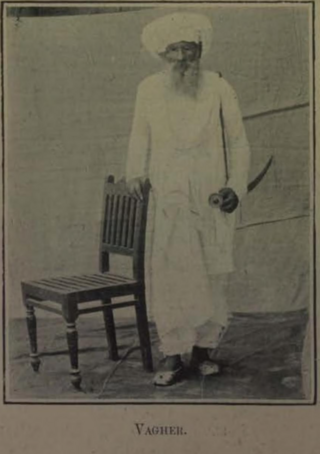
Wagher, Vagher or Waghir is a jāti from the Saurashtra and Kutch regions of Gujarat in India. Some Waghers are Hindu and others are Muslim. They speak Kutchi as a mother tongue.
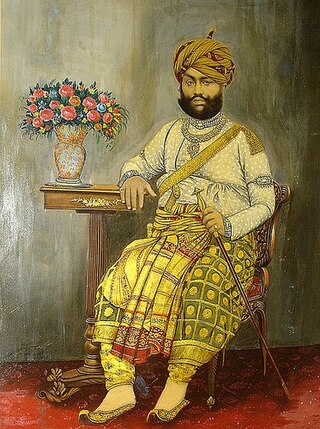
Maharao Pragmalji II, (1839−1875) was the Rao of Cutch, a ruler of Jadeja dynasty who ascended the throne upon death of his father & king Rao Deshalji II on 26 July 1860 and ruled till his death on 19 December 1875.
Hamirsar Lake is a man made lake situated in the centre of Bhuj, the headquarters of Kutch district (Kachchh), Gujarat, India.

Kutch Museum is located in Bhuj, Kutch (Kachchh) district of Gujarat, India. It is the oldest museum of Gujarat which was founded in 1877. It is located opposite Hamirsar Lake. The museum was earlier known as Fergusson Museum.
Alfred High School in Bhuj, Kutch is one of the oldest educational institution of Gujarat and first high school of Kutch. It was founded by Rao of Cutch, Pragmalji II in year 1870 at cost of ₹150,000 (US$1,900). The school was named Alfred High School, after Prince Alfred, the Duke of Edinburgh.
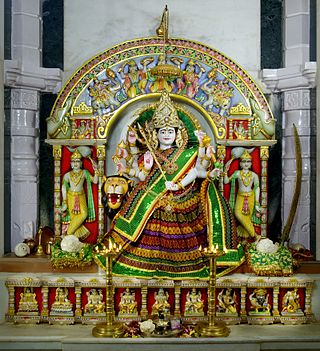
Ashapura Mata is an aspect of Devi, a Hindu goddess. She is one of the kuladevis of Kutch and Rajasthan, and the Jadeja clan of gujarat and Chauhans inhabiting the western indian provinces. She is a goddess regarded to fulfill the wishes of her adherents. In her iconography,

Vijaya Vilas Palace is a summer palace of ADITYA GELOT Maharao of Kutch located on the beach of Mandvi in Kutch, Gujarat, India.
The Warya are a Hindu and Muslim Rajput clan found predominantly in the Punjab and Sindh provinces of Pakistan and in the state of Gujarat in India.

Maharao Pragmulji III of Kutch was the ruler of Kutch from Jadeja dynasty.

Cutch, also spelled Kutch or Kachchh and also historically known as the Kingdom of Kutch, was a kingdom in the Kutch region from 1147 to 1819 and a princely state under British rule from 1819 to 1947. Its territories covered the present day Kutch region of Gujarat north of the Gulf of Kutch. Bordered by Sindh in the north, Cutch State was one of the few princely states with a coastline.

Jakh Botera, Jakhdada, Jakkha Bautera, 72 Yaksha or Bohter Yaksha, literally seventy-two Yaksha warriors, are group of folk deities worshiped widely in Kutch district of Gujarat, India.
Ram Singh Malam was a navigator, architect and craftsman from 18th century Kutch region of India. When his ship got wrecked on a voyage, he was rescued by a Dutch ship which brought him to Holland. He learned several European craft skills there, which were introduced to Kutch upon his return. Despite being patronised by the ruler of Kutch for whom he built palaces including Aina Mahal and memorials, he is celebrated as a maritime folk hero whose artistic influence is still found in the region.